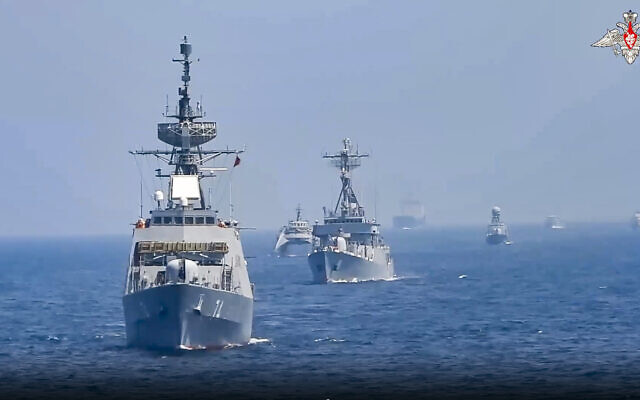- Joint exercises in Gulf of Oman focus on rescuing hijacked merchant ships and feature Chinese and Iranian special ops teams and PLA destroyer
- Observer says emphasis on piracy is ‘clever bit of marketing’ for military cooperation between ‘international pariahs’ Tehran and Moscow
China has conducted a joint Naval exercise with Iran and Russia focused on firing and anti-piracy rescue operations, according to China’s official military newspaper.
The PLA (Peoples Liberation Army) Daily reported on Thursday that the three countries were holding the joint drill, named “Maritime Security Belt – 2024”, from March 11 to 15 in the Gulf of Oman in the Indian Ocean, near Chabahar port in southern Iran.
The five-day joint exercise included training on firing at sea and rescue operations for hijacked merchant ships.
Sources in Iran report that observers from South Africa, Azerbaijan, Kazakhstan, Oman, and Pakistan participated in the exercise, which ends on Friday (the sea phase ended on Thursday).
Among the naval ships involved are the Russian missile cruiser Varyag, supported by the frigate Marshall Shaposhnikov, the Chinese guided-missile destroyer Urumqi, guided-missile frigate Linyi and replenishment vessel Dongpinghu. The Chinese vessels came from the 45th China Naval Escort Task Force off East Africa.
Iran has provided a total of ten naval vessels.
On Tuesday, the three navies conducted firing training against targets set up by an Iranian warship, with the Chinese side serving as the course commander. The drill continued in the evening with night shooting and light communication exercises.
On Wednesday, the joint exercises focused on anti-piracy operations. Warships from the three countries formed two task forces and manoeuvred towards the two merchant ships, represented by Iranian vessels.
Under the command of the guided-missile destroyer Urumqi of the 45th Chinese naval escort task force, six vessels from the People’s Liberation Army and Iranian navy conducted manoeuvring and reconnaissance activities. These included evidence collection and identifying pirates and their activities.
The anti-piracy drill involved special operations teams from China and Iran, who covertly boarded a hijacked ship to subdue the pirates and search the cabins to rescue hostages.
The guided-missile frigate Linyi and the comprehensive supply ship Dongpinghu also took part in the drill.
The Chinese defence ministry said the drill aimed to “jointly maintain regional maritime security.”
The joint exercise comes amid growing confrontations in the Red Sea after a US-led coalition launched counterstrikes against Yemen’s Iran-aligned Houthi militants, who have attacked international and commercial shipping in support of Palestinians in the Gaza war.
China, which stations its warships at a naval base in Djibouti near the Red Sea, has not officially condemned the Houthi attacks. But according to Reuters, Beijing has urged Tehran to rein in attacks on ships in the Red Sea.
On Thursday, Russian news agency Sputnik reported that the Houthis claimed they had “successfully” carried out a test flight of a hypersonic missile with high destructive capability and were “preparing to add these missiles to its military arsenal”, though the report did not provide any evidence to support the claim.
China, Russia and Iran conducted a similar drill in March last year.
Benjamin Barton, associate professor at the University of Nottingham’s Malaysia campus, said closer trilateral cooperation through repeated military drills suggested the exercises were “becoming part of a growing cycle of sustained maritime interaction between the three countries”.
Barton said the drills were a way of building closer ties between countries that were often considered “international pariahs” and “spoilers” – namely Russia and Iran.
“As has been well documented, Iran is providing Russia with quite a bit of military support for its war in Ukraine,” he said.
“Another reason for the drill is to demonstrate a presence in waters that have become something of a new battleground ever since the Houthi rebels began indiscriminately targeting commercial vessels navigating up or down the Suez Canal.”
He added there was also a technical element to the drills as they aimed to “fine-tune operationalisation at sea” in case one or more of the countries needed to deploy ships to the region.
“The inclusion of anti-piracy in my books is simply a mechanism to deflect attention and negative press away from the drill. After all, the fight against piracy was almost universally legitimised by the international community,” Barton said.
“Therefore it raises few eyebrows … So labelling the drill under the auspices of an anti-piracy exercise is a clever piece of marketing to distil the noise this exercise is likely to generate at this time.”

